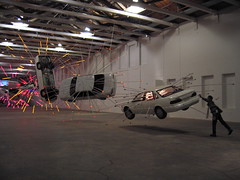Digital tapestries and Google Maps
This week's New Yorker has a fascinating article on how two mathmaticians helped the Metropolitan Museum of Art stitch some 200 cds worth of digital pictures of one of the Unicorn tapestries at the cloisters into a single composite digital image.
It begins with the common analogy that tapestry stitches are analogous to digital pixals, and therein lies the problem. The digital shoot happened while the tapestries were being restored in '98. After a bath in distilled water, and some time off the wall, the tapestry warped enough to make a composite picture difficult. (note: they were shooting at a resolution of 50 microns, or half the width of a hair). Even the process of shooting created inconsistancies, the ref. paper that slid on top as they captured each segment, the camera's sliding mechanism being off by millemetres and so on.
Without meaning to, this segways nicely into Google's news of the week: satellite imaging in maps. Again, we're talking about stitching many thousands of images together to create a compsite, a small fraction of which the searcher sees in their window. High in the blogdex is this man's annotation of Google Maps to indicate various sites from his childhood. Here are some instructions to do one yourself. I just did a brief tour from 409 Wilmers to Lincoln High School.



0 Comments:
Post a Comment
<< Home